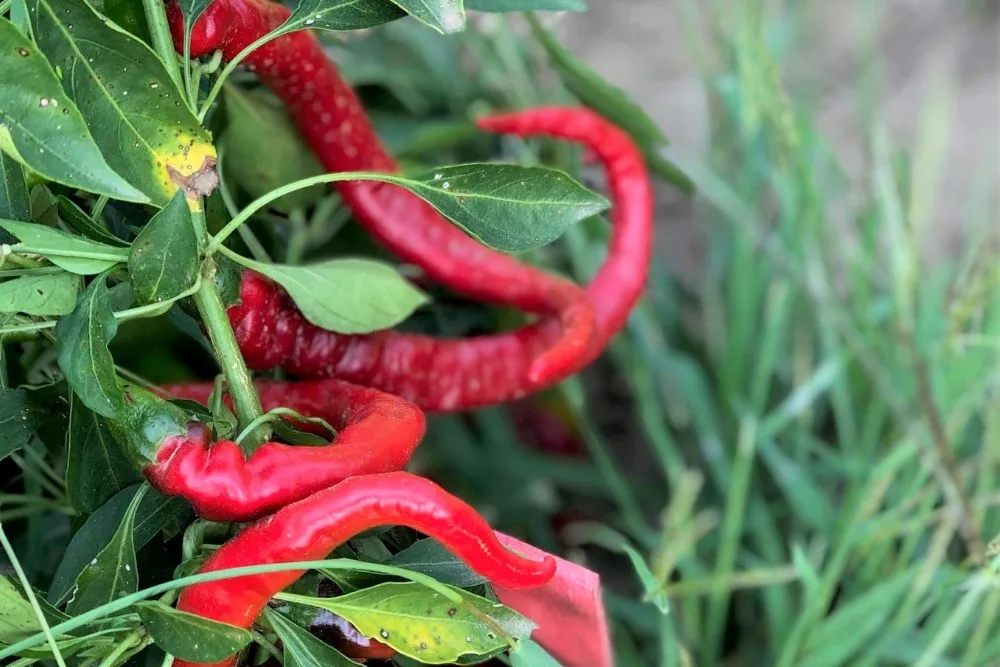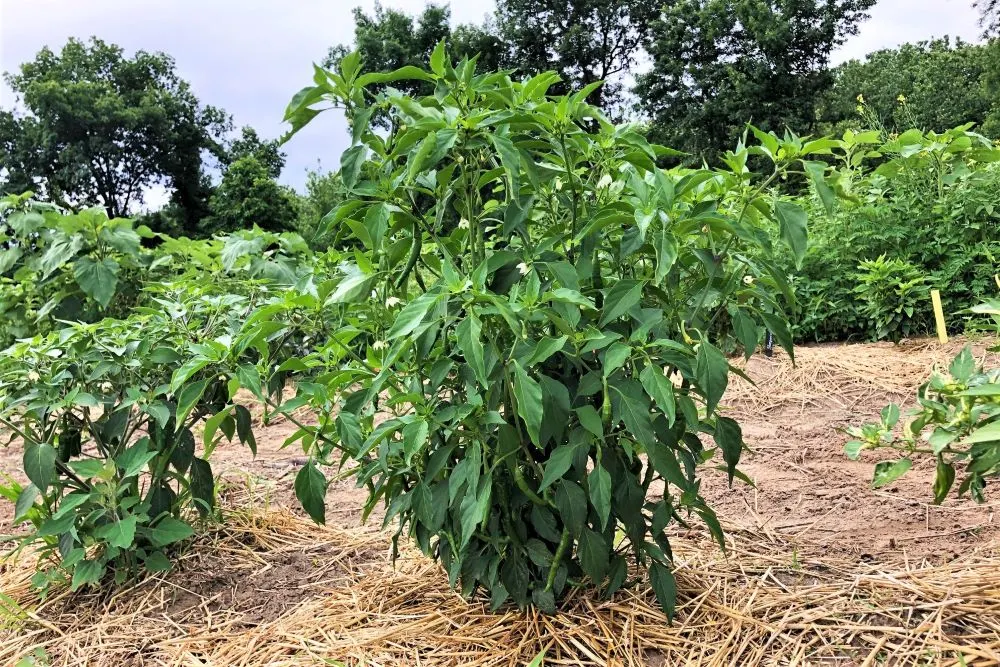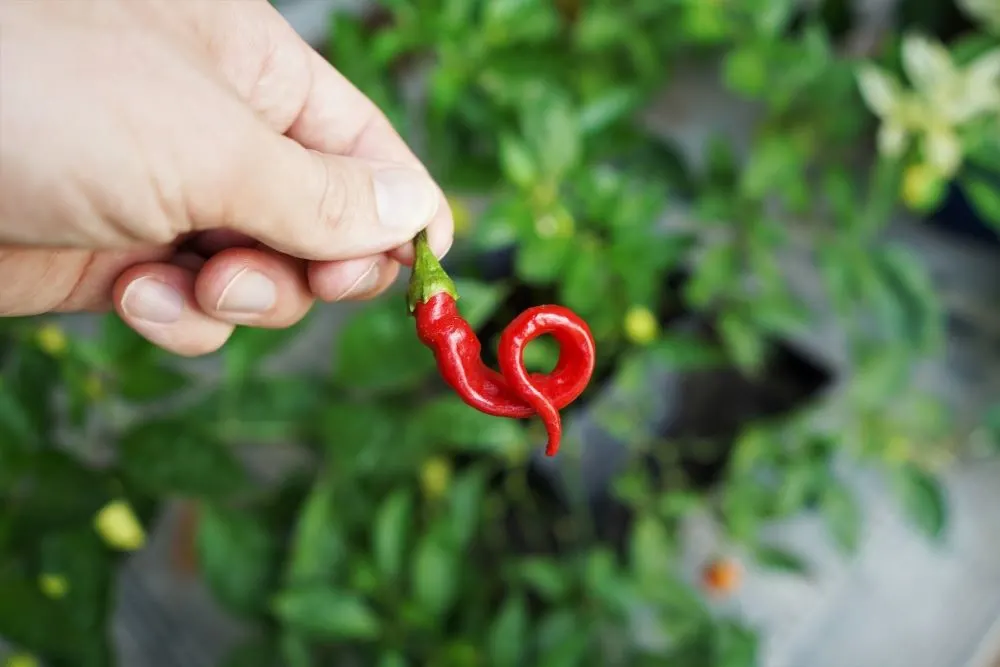If you like spicy food, then I recommend growing your own hot peppers at home. Whether you have a big yard for an in-ground garden bed, or a small balcony in your apartment, you can grow peppers.
Cayenne peppers are some of the most famous and popular hot chilies. With fresh cayennes, you can make hot sauce, spicy cayenne powder, or use them in cooked dishes.
One of the most common questions for new growers is when to pick cayenne peppers off the plant. In this article, I’ll discuss the stages of a cayenne pepper plant’s growth, when to harvest cayennes, and other common questions.

It is important to pick cayenne peppers at the right time, as they have a relatively short window of optimal ripeness. After reading this, you’ll know exactly when to pick your cayennes for maximum flavor and heat!
When To Pick Cayenne Peppers
If you are growing from seed, you have waited months for the plants to produce, so when can you start picking?
In short, cayenne peppers are ready to pick when they have reached a mature size and have ripened to a red color. Some cayenne variants ripen to other colors, such as yellow or orange, but avoid picking them while they are still green.

How long do cayenne peppers take to ripen?
I am no stranger to feeling impatient while waiting for peppers ripen. Cayenne peppers can take a while to change colors, up to 1 month after reaching their full size. However, I always recommend waiting for the final color change, especially with cayennes.
Ripe cayennes have more sweetness and a much improved flavor over green fruits. However, as you’ll see soon, green cayennes can still be used in cooking if necessary.
Plus, cayennes will be at their peak heat level just after ripening. So, for the most flavor and heat, harvest right when the peppers change color.
Tips for harvesting cayennes
While it is pretty straightforward, I want to share a few tips for harvesting your cayenne peppers properly. These will help you know exactly how and when to harvest.
- Wait for the color to change
- Pull the stem with one hand and hold the branch with the other to avoid damaging the plant
- If you plan to save the seeds, harvest a few days after ripening
Cayenne Peppers Not Turning Red
We have seen multiple accounts of growers with cayenne peppers that will not turn red. The peppers stay green, and eventually dry up, or rot and fall off the plant. This is abnormal, but it seems to happen more frequently with cayennes than other pepper varieties.
There are a few possible causes for cayenne peppers not turning red:
- First, the plants may simply need more time to ripen the peppers. As I stated, cayenne peppers can take up to 30 days (or longer) to ripen from green to red. The duration will depend on the temperature, water and nutrient content in the soil, and the specific variety that you are growing. Be patient and more often than not your peppers will eventually turn.
- Another possible cause is low light conditions. Most pepper plants will do best in full-sun conditions. Partially shaded plants will usually perform fine, but we have found that these plants produce less spicy, less flavorful pods. They can also take longer to fully ripen, so consider how much sunlight your plants are receiving and change their location to full sun if possible.
- Lastly, you could be dealing with pests or disease. When a cayenne fruit becomes damaged, it can easily dry out and fall from the plant before ripening. If your peppers rot before turning red, inspect your plants closely for any signs of an infestation or disease.
Green Cayenne Peppers
Another common question we see is whether green cayenne peppers are edible. Unripe cayennes are perfectly edible, and can be used the same way you would red cayennes. However, the flavor will be different, and heat levels may be lower too.

Green cayenne peppers are usually slightly bitter and have a more vegetative flavor (grassy). In our experience, this depends on exactly how immature the peppers are. If the seeds inside are just beginning to form (soft and tiny white seeds), then the pepper will be much more bitter. If the pepper is closer to ripening, it will be similar to a red ripe cayenne, with a bit less sweetness.
If the season is coming to an end, and the temperatures are dropping, harvest your green cayenne peppers before a frost. The green pods can be used in fresh salsa, stir fry dishes, or frozen for later.
Will green cayennes turn red off the plant? If your cayenne peppers are close to ripening when you pick them, there is a chance they will turn red after harvesting. Keep them in a warm location (out of the refrigerator) for 3-4 days to encourage faster ripening. If they don’t start to turn red within a week, they will probably stay green.
The Cayenne Pepper Plant
The word cayenne actually refers to a large group of chilies from the Capsicum annuum species. They have been used by humans for hundreds of years, with some records dating back to the mid 1500s.
Now, cayenne peppers are grown in abundance in the US, and are primarily used to make popular hot sauces like Frank’s RedHot and buffalo-style sauces.
Its name is also used for the popular spice ‘cayenne powder,’ though it isn’t a guarantee that the peppers found in it are actually cayennes. The FDA says the spice can be made with the dried fruits of any C. annuum or C. frutescens cultivar.
Cayenne pepper plants are usually between 2-4 feet tall with a bushy structure. Plants are usually highly prolific, producing 10-30 ripe pods at a time, depending on the variety.

Some cayenne varieties can benefit from staking or training in order to keep the fruits from resting on the ground. They will grow best in a full sun location, but can still be productive in partial shade.
Once the seedlings are about 3 weeks old, the plants begin growing more vigorously. Harvesting typically begins between 60-80 days after transplanting outdoors, depending on the climate and cultivar.
Types of cayenne peppers
By far the most common type of cayenne is the red cayenne pepper. However, there are many other cayenne types, including purple, yellow, and super long cayennes.
If you want to save some time and effort, we grew and tested 7 varieties to find the best cayenne pepper varieties.
Best cayenne types (seeds):

One of the best cultivars is the hybrid ‘Cayennetta.’ It won an AAS award in 2012 for its great flavor and compact, high-yielding plants. The buena mulata is a unique type of cayenne, with beautiful pods that are purple before they ripen to a deep red color.
Cayenne Pepper Growth Stages
Cayenne pepper plants grow similarly to other C. annuum varieties. They should be started from seed about 6 weeks prior to the last local frost date. Once the temperatures are consistently above 55°F, plants can be transplanted outdoors.
After moving outside, cayenne peppers will typically grow to a mature size of 2-4 feet, and then begin setting flowers and fruits. Container plants should be fertilized regularly to ensure the plants have the nutrients they need through the harvest period.
- Seedling. Like any pepper plant, cayennes will start as a slow-growing seedling. Early growth is sluggish, but proper lighting and feeding are critical. Young cayennes need at least 14 hours of light daily to establish a strong main stem and healthy leaves. We highly recommend using a grow light if you plan grow from seed.
- Growth. Once cayennes are transplanted, they will continue to grow more branches and foliage. The goal during this stage is to encourage lots of branches and leaves. If plants are kept in pots that are too small, they may begin flowering prematurely. We recommend removing early flower buds until the plant is established outside.
- Flowering. After plants reach a mature size, flowers should begin forming. The flowers will eventually turn into the fruits, so the more you see, the better!
- Fruiting. Each flower that is successfully pollinated has the potential to become a cayenne pepper. Pollination is taken care of by the wind, and also by insects such as bees and wasps. Indoor plants may need some help via hand pollination or a gentle shake. Once a pepper begins to form, the flower petals will drop and the fruit will grow.
- Ripening. Young cayenne peppers are green in color. Once the peppers reach a mature size, they will begin ripening. This can take between 2-4 weeks depending on the environment and cultivar, and the final peppers are typically bright red.

How Hot is a Cayenne Pepper?
Since there are so many different types of cayenne peppers, heat levels vary widely. Some cayennes, like the corbaci cultivar, are sweet (no heat), while others, like the hot portual, are very spicy.
The most common type of hot cayenne peppers range from 30,000-50,000 SHUs on the Scoville scale. This is quite spicy, and makes cayennes perfect for making hot sauce or spicy salsa.

Cayenne Pepper Uses
Cayenne peppers have a long and slender shape with fairly thin walls. This means they aren’t much use for stuffing or grilling, but they are perfect for many other things.
- Dehydrating. One of the easiest ways to use fresh cayennes is to dry them for powder or flakes. Making cayenne pepper powder is super simple, and can be done with a food dehydrator, an oven, or even hang-dried. Grind up the fully dried pods in a coffee grinder and store for up to a year.
- Hot sauce. Cayenne peppers are the perfect candidate for making a homemade hot sauce. They have medium heat that most can enjoy, and pair well with a variety of other fruits and vegetables. Experiment and create something unique from your garden!
- Fermentation. Cayenne peppers can be fermented for storage, or as a precursor to making hot sauce. Frank’s RedHot sauce contains fermented cayenne pepper mash. The fermentation process develops an improved flavor of the fresh peppers.
- Freezing. If you just want a quick way to store fresh peppers to avoid them spoiling, freeze them. You can use freezer bags, or ideally, a vacuum sealer for the longest storage time.
- Salsa. One of my favorite summertime snacks is fresh, homemade salsa. Tomatoes and peppers usually ripen around the same time, so combine them with onions and other veggies to make the perfect spicy dip.
- Frying. I like my food spicy, and cayenne peppers are right in the sweet spot for heat level. Chop up some fresh cayennes and heat up your home cooked meals.
- Saving seeds. If you want to grow again next year, you can save seeds from your cayenne peppers. If you have other pepper types growing nearby, it is possible for them to have cross pollinated, so it may be best to use store bought seeds.

I hope this article helped you learn when to harvest cayenne peppers from your plants. Once you have your first season behind you, you’ll be much more confident when it is time to pick!


Nev
Monday 22nd of January 2024
How long can I leave growing they are about the right size and have been green all the time and I grew them from a red cayenne pepper
peppergeek
Thursday 25th of January 2024
They will eventually turn red. Keep them well-watered and plenty of sun, and be patient!
Lucas Eggers
Wednesday 17th of August 2022
I am having issues with the peppers drying out while ripening. Some will start to shrivel up and dry before they become fully ripe. Soil is moist but not soaked (watering every other day because of temps getting into mid to upper 90s), pretty heavy soil unfortunately because of our local soil (I do mix with potting mix or garden bed mix), I cover with blankets during mid day for a few hours, and I fertilize every 2 weeks. Any idea why I'm having this issue? That's my only issue considering my season is only 77 days here in Montana. I probably have a couple thousand peppers coming in on about 20 cayenne plants. That is if they all ripen up before frost. Plus I have another 20 Fresno and 20 habanero plants too that I'm waiting on fruit to ripen. Probably another few hundred on those too. Lots of hot sauce coming this fall!
peppergeek
Saturday 20th of August 2022
Cayenne peppers are notorious for this issue. The longer, slim pod shapes tend to suffer from drying on the plant, sometimes even before ripening. The high temperatures definitely can play a role in causing it, as the plants will use more water via transpiration through leaves, and it may leave the ends of the fruits lacking in terms of moisture content. The pods should still be usable, so that is a plus!
Kevin
Tuesday 26th of July 2022
Great article thanks for sharing